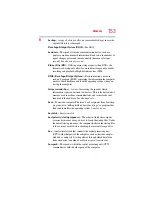
Glossary
159
LAN (Local Area Network)
—A group of computers or other devices
dispersed over a relatively limited area and connected by a
communications link that enables any device to interact with any
other on the network.
LED (Light Emitting Diode)
—A solid state lamp (SSL) that uses
light-emitting diodes (LEDs) as the source of light, which offers
long life and high efficiency output. Multiple diodes are used
together, since the light created by individual light-emitting diodes is
small compared to incandescent and compact fluorescent lamps.
LCD (Liquid Crystal Display)
—A type of display that uses a liquid
substance between two transparent electrode panels. When an
electric current passes through the electrodes, the molecules in the
liquid form a crystalline pattern that polarizes the light passing
through it. A filter over the electrodes permits only non-polarized
light to pass to the surface of the display, creating light and dark
pixels.
load
—To move information from a storage device (such as a hard disk)
into memory for processing.
local area network
—See
LAN.
logical drive
—A section of a disk that is recognized by the operating
system as a separate disk drive. A system’s logical drives may differ
from its physical drives. For example, a single hard disk drive may
be partitioned into two or more logical drives.
M
memory
—Typically refers to the computer’s main memory, where
applications are run and data is temporarily stored and processed.
Memory can be volatile and hold data temporarily, such as RAM, or
it can be nonvolatile and hold data permanently, such as ROM. A
computer’s main memory is RAM. See also
RAM
,
ROM.
microprocessor
—See
Central Processing Unit (CPU).
MIDI (Musical Instrument Digital Interface)
—A standard for
connecting musical instruments, synthesizers, and computers. The
MIDI standard provides a way of translating music into a form
computers can use, and vice versa.
motherboard
—The computer’s main circuit board that contains the
processor, memory, and other primary components.
MS-DOS prompt
—See
system prompt.











































